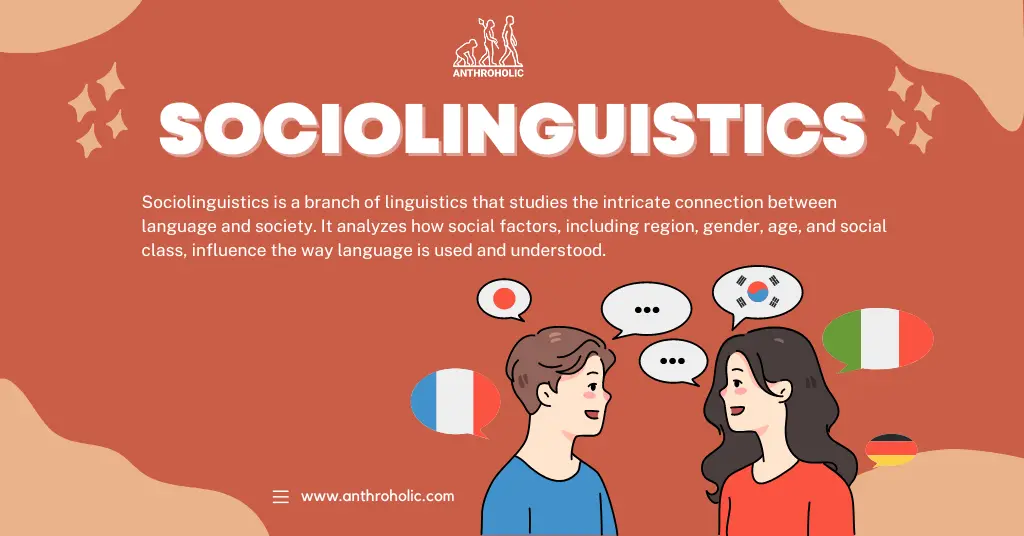AI Answer Evaluation Platform Live Now. Try Free Answer Evaluation Now
Sociolinguistics
Sociolinguistics is a branch of linguistics that studies the intricate connection between language and society. It analyzes how social factors, including region, gender, age, and social class, influence the way language is used and understood [1]. This field is broadly divided into two primary paradigms: Interactionist Sociolinguistics and Variationist Sociolinguistics.

Interactionist Sociolinguistics
Interactionist Sociolinguistics emphasizes the social implications of language use in conversation and other forms of interaction. It examines the subtle ways in which individuals express social identities and negotiate social relationships through language [2].
Key Elements
- Contextualization: Contextualization pertains to how speakers use linguistic and non-linguistic signs to signal the contextual assumptions that frame their talk [3].
- Indexicality: Indexicality refers to the process by which language use points to (or ‘indexes’) aspects of the social context, including the speaker’s identity and social relationships [4].
- Negotiation of Identity: This explores how speakers dynamically construct and negotiate their social identities in interaction [5].
Research Focus
Interactionist sociolinguistic research often employs micro-ethnographic methods, including discourse analysis and conversation analysis, to study language in its social context.
Variationist Sociolinguistics
Variationist Sociolinguistics, on the other hand, explores the systematic nature of the variation observed in spoken language, examining how social factors correlate with patterns of linguistic variability.
Key Concepts
- Linguistic Variables: Linguistic variables are distinct phonetic, morphological, or syntactic features that vary across different social groups.
- Sociolinguistic Variables: These refer to social factors, such as age, gender, socio-economic status, or geographic location, that can influence linguistic behavior.
- Internal and External Factors: Variationist sociolinguists distinguish between internal (linguistic) factors and external (social) factors when analyzing language variation.
Research Techniques
Variationist sociolinguistics often utilizes quantitative methods, using tools such as multivariate statistical analysis, to uncover correlations between social and linguistic variables.
| Interactionist Sociolinguistics | Variationist Sociolinguistics |
|---|---|
| Focuses on the social implications of language use | Focuses on the systematic nature of the variation observed in spoken language |
| Utilizes micro-ethnographic methods | Utilizes quantitative methods |
| Explores contextualization, indexicality, negotiation of identity | Examines linguistic variables, sociolinguistic variables, internal and external factors |
Interactionist and Variationist Sociolinguistics: A Synergistic Relationship
While distinct in their methodologies and foci, Interactionist and Variationist Sociolinguistics complement each other, providing a comprehensive understanding of the intersection of language and society. For example, Interactionist approaches can elucidate how individuals negotiate social identities through language in real-time interaction, while Variationist approaches can reveal broader patterns of how social identities correlate with linguistic variation.
Case Studies: The Application of Interactionist and Variationist Sociolinguistics
To further understand how these two branches of sociolinguistics operate in research, let’s explore two case studies.
Case Study 1: Code-Switching and Identity Negotiation in Bilingual Communities (Interactionist Sociolinguistics)
Interactionist sociolinguistics can be employed to study bilingual communities where speakers alternate between languages, a phenomenon known as code-switching. This process often serves to signal social identity and interpersonal relationships. For instance, in a study of a Moroccan community in the Netherlands, speakers were observed to switch between Dutch and Tarifit (a Berber language) to assert different aspects of their identities. Code-switching was not arbitrary but rather indexed particular social contexts and relationships, illustrating the interactionist principles of contextualization and indexicality.
Case Study 2: The Northern Cities Shift in the United States (Variationist Sociolinguistics)
Variationist sociolinguistics has been used to analyze the Northern Cities Shift, a chain shift of vowel sounds in the Inland North region of the United States. This shift is characterized by systematic changes in vowel pronunciation, representing a linguistic variable. Labov’s study revealed that this shift is more prominent in cities than in rural areas and that it is more common among middle-aged and younger speakers, representing sociolinguistic variables. These patterns highlight the systematic nature of linguistic variation and its correlation with social factors, key themes in variationist sociolinguistics.
Concluding Remarks: The Value of Sociolinguistics in Linguistic Anthropology
Sociolinguistics, with its interactionist and variationist branches, plays a pivotal role in linguistic anthropology. It aids in our understanding of language as an inherently social phenomenon, reflecting and shaping social identities, relationships, and realities. This field underscores the power of language in constructing our social world, reaffirming the significance of linguistic anthropology in social science research.
References
[1] Wardhaugh, R., & Fuller, J. M. (2015). An Introduction to Sociolinguistics. Wiley Blackwell.
[2] Gumperz, J. J. (1982). Discourse Strategies. Cambridge University Press.
[3] Auer, P., & Di Luzio, A. (1992). The Contextualization of Language. John Benjamins Publishing Company.
[4] Silverstein, M. (2003). Indexical order and the dialectics of sociolinguistic life. Language & Communication, 23(3-4), 193-229.
[5] De Fina, A., Schiffrin, D., & Bamberg, M. (2006). Discourse and Identity. Cambridge University Press.




